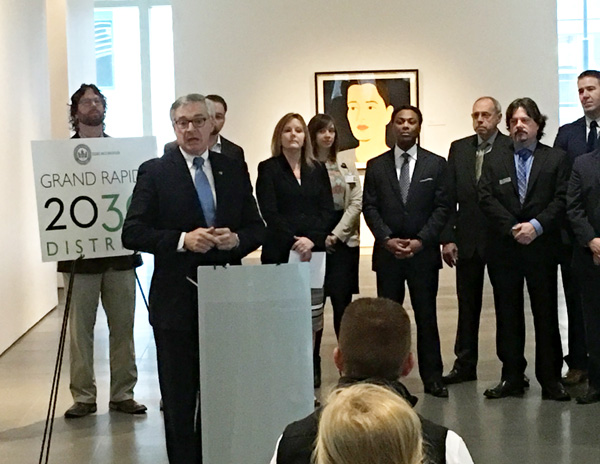April 27, 2015, architect Ed Mazria gave the 19th annual Wege Lecture urging Grand Rapids to join Architecture 2030, the program he founded in 2006 to cut carbon emissions from buildings in half by 2030. Noting that 50% of the energy in the U.S. is consumed by buildings and 75% of all greenhouse gases come from urban centers, Mazria’s environmental mission targets cities.
The day after Mazria’s Wege Lecture, the city of Grand Rapids began the process that would qualify it to be named a 2030 city by the end of the year. Mayor George Heartwell and his fellow city leaders were not daunted by the fact that the first 11 cities took a lot longer than eight months to sign up the necessary private and public building owners. He credited The Wege Foundation for its generous grant to the West Michigan chapter of the United States Green Building Council that helped grease the skids to make the city’s December goal happen.
In a press conference announcing that Grand Rapids had qualified as the 12th 2030 city in the country, Mayor Heartwell made it clear the “spirit of Peter Wege” was happily present. The collaborative action by local private and public building owners committing 10 million square feet of buildings to 2030 exemplified the way Peter liked to see things get done.
The significance of holding the press conference at the Grand Rapids Art Museum reinforced Mayor Heartwell’s comments. Peter Wege was the moving force behind this first U.S.G.B.A. museum in the world. And while the GRAM board offered to rename it for Wege, the response was vintage Peter. “This museum belongs to the people of Grand Rapids and that is how the name will stay.”
Now GRAM sits in the heart of the 12th city in the United States to fight global climate change by signing on to 2030.
Click here for 2030Districts.com
In the Grand Rapids Art Museum in mid-December, 2015, Mayor George Heartwell announced Grand Rapids has just been named the 12th 2030 city in the nation qualifying in record time.

